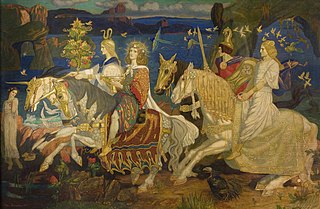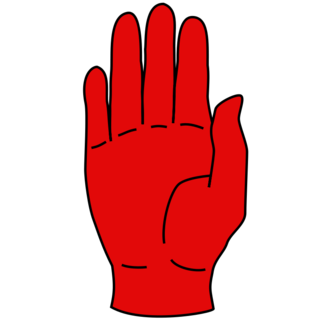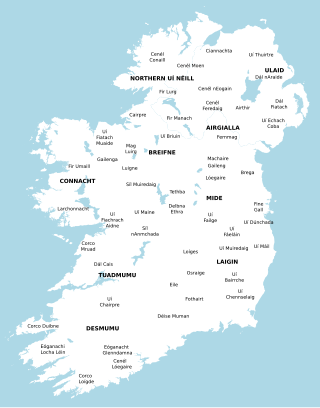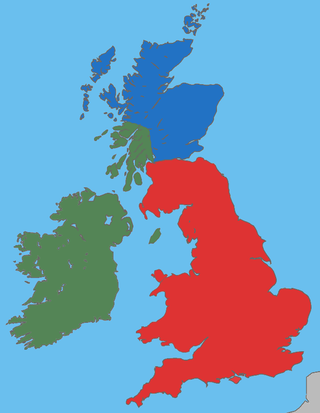Related Research Articles

Irish mythology is the body of myths indigenous to the island of Ireland. It was originally passed down orally in the prehistoric era. In the early medieval era, some myths were transcribed by Christian monks, who heavily altered and Christianised the myths. Irish mythology is the best-preserved branch of Celtic mythology.

The TuathaDé Danann, also known by the earlier name Tuath Dé, are a supernatural race in Irish mythology. Many of them are thought to represent deities of pre-Christian Gaelic Ireland.

In medieval Irish myth, the Fir Bolg are the fourth group of people to settle in Ireland. They are descended from the Muintir Nemid, an earlier group who abandoned Ireland and went to different parts of Europe. Those who went to Greece became the Fir Bolg and eventually return to Ireland, after it had been uninhabited for many years. After ruling it for some time and dividing the island into provinces, they are overthrown by the invading Tuatha Dé Danann.

The Belgae were a large confederation of tribes living in northern Gaul, between the English Channel, the west bank of the Rhine, and the northern bank of the river Seine, from at least the third century BC. They were discussed in depth by Julius Caesar in his account of his wars in Gaul. Some peoples in southern Britain were also called Belgae and had apparently moved from the continent. T. F. O'Rahilly believed that some had moved further west and he equated them with the Fir Bolg in Ireland. The Roman province of Gallia Belgica was named after the continental Belgae. The term continued to be used in the region until the present day and is reflected in the name of the modern country of Belgium.

Lebor Gabála Érenn is a collection of poems and prose narratives in the Irish language intended to be a history of Ireland and the Irish from the creation of the world to the Middle Ages. There are a number of versions, the earliest of which was compiled by an anonymous writer in the 11th century. It synthesised narratives that had been developing over the foregoing centuries. The Lebor Gabála tells of Ireland being settled six times by six groups of people: the people of Cessair, the people of Partholón, the people of Nemed, the Fir Bolg, the Tuatha Dé Danann, and the Milesians. The first four groups are wiped out or forced to abandon the island; the fifth group represents Ireland's pagan gods, while the final group represents the Irish people.

The Brigantes were Ancient Britons who in pre-Roman times controlled the largest section of what would become Northern England. Their territory, often referred to as Brigantia, was centred in what was later known as Yorkshire. The Greek geographer Ptolemy named the Brigantes as a people in Ireland also, where they could be found around what is now Wexford, Kilkenny and Waterford, while another people named Brigantii is mentioned by Strabo as a sub-tribe of the Vindelici in the region of the Alps.

The Cruthin were a people of early medieval Ireland. Their heartland was in Ulster and included parts of the present-day counties of Antrim, Down and Londonderry. They are also said to have lived in parts of Leinster and Connacht. Their name is the Irish equivalent of *Pritanī, the reconstructed native name of the Celtic Britons, and Cruthin was sometimes used to refer to the Picts, but there is a debate among scholars as to the relationship of the Cruthin with the Britons and Picts.

Caladbolg is the sword of Fergus mac Róich from the Ulster Cycle of Irish mythology.

Niall Noígíallach, or Niall of the Nine Hostages, was a legendary, semi-historical Irish king who was the ancestor of the Uí Néill dynasties that dominated Ireland from the 6th to the 10th centuries. Historical Irish annalistic and chronicle sources place his reign in the late 4th and early 5th centuries, although modern scholars date him about half a century later.
Túathal Techtmar, son of Fíachu Finnolach, was a High King of Ireland, according to medieval Irish legend and historical tradition. He is said to be the ancestor of the Uí Néill and Connachta dynasties through his grandson Conn of the Hundred Battles. The name may also have originally referred to an eponymous deity, possibly even a local version of the Gaulish Toutatis.

Primitive Irish or Archaic Irish, also called Proto-Goidelic, is the oldest known form of the Goidelic languages, and the ancestor of all languages within this family.

The Iverni were a people of early Ireland first mentioned in Ptolemy's 2nd century Geography as living in the extreme south-west of the island. He also locates a "city" called Ivernis in their territory, and observes that this settlement has the same name as the island as a whole, Ivernia. It was probably once the name given to all the peoples of Ireland, but by Ptolemy's time had a more restricted usage applicable to the inhabitants of the south-west. These Iverni can be identified linguistically with the Érainn, a people attested in Munster and elsewhere in the early Middle Ages.

Erris is a barony in northwestern County Mayo in Ireland consisting of over 230,452 acres (932.61 km2), much of which is mountainous blanket bog. It has extensive sea coasts along its west and north boundaries. The main towns are Belmullet and Bangor Erris. The name Erris derives from the Irish 'Iar Ros' meaning 'western promontory'. The full name is the Iorrais Domnann, after the Fir Bolg tribe, the Fir Domnann. To its north is the wild Atlantic Ocean and the bays of Broadhaven and Sruth Fada Conn and to its west is Blacksod Bay. Its main promontories are the Doohoma Peninsula, Mullet Peninsula, Erris Head, the Dún Chiortáin and Dún Chaocháin peninsulas and Benwee Head.
The Laigin, modern spelling Laighin, were a Gaelic population group of early Ireland. They gave their name to the Kingdom of Leinster, which in the medieval era was known in Irish as Cóiced Laigen, meaning "Fifth/province of the Leinstermen", where their descendants ruled till the 17th century. Their territory, located in south-east Ireland, is thought to have once extended from the River Shannon to the River Boyne. The surnames of those descended from the Laigin are still counted amongst the most numerous in Ireland.

Glencastle is a small village, electoral division and townland in the northwest of County Mayo, Ireland. The townland of Glencastle has an area of approximately 2,337 acres (9.46 km2).

Uí Bairrche was an Irish kin-based group that originally held lands in the south of the ancient province of Leinster. Another south Leinster kin group associated with the Uí Bairrche were groups of the Fothairt. The south of Leinster was dominated by the Uí Chennselaig in the 8th century. Uí Bairrche held lands around Carlow, however Uí Chennselaig expansion split the kindred. The result was that one Uí Bairrche branch persevered in the Barrow valley; and another was forced to move south towards the Wexford coast.
Cían d'Fhearaibh Bolg, last King of the Senchineoil of Magh Senchineoil, now in County Galway, Ireland.

The Insular Celts were speakers of the Insular Celtic languages in the British Isles and Brittany. The term is mostly used for the Celtic peoples of the isles up until the early Middle Ages, covering the British–Irish Iron Age, Roman Britain and Sub-Roman Britain. They included the Celtic Britons, the Picts, and the Gaels.

Celtic mythology is the body of myths belonging to the Celtic peoples. Like other Iron Age Europeans, Celtic peoples followed a polytheistic religion, having many gods and goddesses. The mythologies of continental Celtic peoples, such as the Gauls and Celtiberians, did not survive their conquest by the Roman Empire, the loss of their Celtic languages and their subsequent conversion to Christianity. Only remnants are found in Greco-Roman sources and archaeology. Most surviving Celtic mythology belongs to the Insular Celtic peoples. They preserved some of their myths in oral lore, which were eventually written down by Christian scribes in the Middle Ages. Irish mythology has the largest written body of myths, followed by Welsh mythology.
References
- ↑ J.T. Koch, Celtic Culture: a historical encyclopedia (2006), p. 750.
- ↑ T. F. O'Rahilly, Early Irish History and Mythology (Dublin Institute for Advanced Studies 1946)
- ↑ J.T. Koch, Celtic Culture: a historical encyclopedia (2006), p. 750.
- ↑ "Visit Erris, North West Mayo, Ireland – Accomodation, Food & Drink, Watersports, Cycling, Walking, Fishing and more" . Retrieved 4 May 2024.
- ↑ J.T. Koch, Celtic Culture: a historical encyclopedia (2006), p. 750.